Crime and Punishment (1935)
Directed by: Josef von Sternberg
Written by: Fyodor Dostoevsky, Joseph Anthony, S.K. Lauren
Starring: Edward Arnold, Marian Marsh, Peter Lorre, Tala Birell
USA
AVAILABLE ON BLU-RAY: 29th JULY 2019, from ARROW ACADEMY
RUNNING TIME: 88 mins
REVIEWED BY: Dr Lenera, Official HCF Critic
University student Roderick Raskolnikov graduates with honours, but, even though he becomes an authority on crime, he lives in poverty. When several circumstances make his financial situation even worse, he murders a cruel pawnbroker and takes her valuables. The next day, Roderick is arrested, not for the pawnbroker’s murder but for overdue rent. Inspector Porfiry has Roderick observe the interrogation of an innocent prisoner suspected of the pawnbroker’s murder. Porfiry, who has solved all crimes assigned to him, confides to Roderick that he is willing to send an innocent man to prison in order to maintain his record.…
I made myself read a ‘classic’ book once a year until recently when I’ve slipped somewhat. Fyodor Dostoevsky’s Crime And Punishment was certainly one of the ones that made the greatest impression on me. However, I didn’t subsequently go and check out some of the movie versions which is what I normally do. This was because the study of the moral dilemma and mental anguish of a killer was so “internal” that I failed to see how any adaptation for a very different medium would do it justice. Much of the book consists of the main protagonist’s thoughts, and this just wouldn’t translate to a film. The screenwriters would have to remove this aspect unless they relied on a voice-over [not a cinematic device I like, film noir and Apocalypse Now excepted of course]. I had no idea that the mystery Arrow release our webmistress Bat had sent me [she’d forgotten the name and I do like surprises] was going to be a Blu-ray of an early film version, but quickly changed my mind and became enthusiastic about giving it a go. It was made at a film when Hollywood was churning out loads of adaptations of literary classics despite the heavy censorship of the time often requiring extensive alterations. And it actually comes off surprisingly well. Of course the story is heavily condensed and the themes simplified, but a surprising amount of the psychological stuff makes it in there, while Peter Lorre and Edward Arnold are more than good enough to hold the attention in what is largely a two-hander between two individuals: the man who commits murder, and the police inspector who suspects him. The very small budget does show, but the simplicity of the sets provides a stark, claustrophobic feel that seems to be suited to the material. If MGM had made this, it would have looked very lush and detailed, but I’m not sure that would have worked as well.
This was made soon after director Joseph von Sternberg and Paramount studios had ended their eight-year affiliation with the completion of The Devil Is A Woman, the director’s seventh and final collaboration with Marlene Dietrich. Producer B. P. Schulberg, recently expelled from Paramount, joined Columbia Pictures and quickly brought Sternberg on board in a two-picture contract with the poorly financed studio. Columbia head Harry Cohn approved the project in part because Crime and Punishment, first published in 1866, was in the public domain and would require no copyright fees, while the cast was a mix of Columbia contract artists as well as “supers”—freelance players engaged without a contract, for a modest fee. Production code officials had reviewed a recent stage adaption of the novel and warned that the narrative has two things the ridiculous censors of the time didn’t like: “a failure of the police to arrest and prosecute the young college student” and: “the characterisation of the heroine as a prostitute”. Sternberg was his usual demanding self on set, Mrs. Patrick Campbell [the pawnbroker saying that: “He wanted only obedience and silence to get his own effects“. The film did mediocre business and received a mixed critical response, while it was also overshadowed by a French version of the novel. Sternberg later expressed dislike for it, saying that:“it was no more related to the true text of the novel than the corner of Sunset Boulevard and Gower is related to the Russian environment.” His son, Nicholas Josef von Sternberg, would eventually work as a cinematographer in another adaptation of the same story in 2002.
Arnold is billed before Lorre, which perhaps isn’t surprising for the time even though Lorre is in nearly every scene and Arnold only in about a third of them. One can’t help but be amused by the billing of Lorre as “the celebrated European star” even though Mad Love with him in had already come out. By the way it’s not clear when and where the story is supposed to be taking place. We’re certainly not in the Russia of the 1866 going by the contemporary dress, though there are no telephones and cars either. Anyway, Lorre gets a nice introduction, stepping forward from a group of other darkened students. Roderick is graduating, and begins writing some well received and revolutionary material about crime, but his name is not mentioned, and the pittance he gets for them is nowhere near enough to cover his six-month overdue rent. When Roderick learns that his family is coming to visit and is embarrassed at his impoverished surroundings, he goes to pawn the heirloom watch he received for graduation. At the pawnbroker’s, he sees a young prostitute Sonya receive only one ruble for her valuable Bible, and, when pushed out the door by the pawnbroker, she loses the ruble. Of course a 1935 film couldn’t properly state her profession, but the pawnbroker’s insults and mentioning of her “gentlemen friends“ are enough to give us the idea. We are also made to seriously dislike this mean, nasty old woman, and allowed to relate a bit to the obvious thoughts that Roderick is already having, saying things like: “she ought to be stepped upon” or: “someone should push her into the next world”. When he learns that Sonya supports her family, he gives her the rubles he receives for his watch. Later, Roderick’s mother and sister, Toni, arrive at his apartment. Toni lost her job because her employer’s husband tried to force himself on her. With the family in dire poverty, Toni has agreed to marry the pompous, aging Lushin, and he’s so arrogant that one almost wishes that Roderick would do him in too.
In any case, angry at Toni for selling herself to Lushin, and desperately in need of money, Roderick kills the cruel old pawnbroker with a poker, and rummages through her room for valuables though fails to find the large sum of money she had hidden. We don’t want him to be discovered when two men knock at the door of the pawnbroker’s apartment, we don’t want people to see him leave. We are partly with him and almost want him to have got away with it, which is quite brave for a Hollywood film of the time. We even panic when, the next day, Roderick is arrested, and utter a sigh of relief when it’s not for the pawnbroker’s murder but for overdue rent. Inspector Porfiry is eager to meet the criminal expert, and he has Roderick observe the interrogation of a prisoner suspected of the pawnbroker’s murder. He’s an unpleasant wife-beating drunk, so we don’t mind much if he’s punished for the killing, do we? Now I wonder, does Porfiry suspect Roderick immediately? I’m not sure, but he probably does when he faints in his office. The excitement and value to Porfiry [he has a 100% record] of having a crime expert help him is still considerable for a while, but Porfiry’s suspicions increase. One of Roderick’s theories, one that he doesn’t mind mentioning, about some people being so much greater than the norm that they should be allowed to cross moral boundaries, doesn’t help him. For a crime expert committing a crime he’s surprisingly slipshod, but it’s more his own arrogance that gives him away. He becomes more and more convinced that he’s superior to those around him.
Lorre, who’s really rather miscast in terms of appearance, is wonderful in the scenes where he throws money around, insults people, and puts his foot on a chair in the Inspector’s office. Roderick’s personality changes and he’s then far less sympathetic, though still shows true anguish in his scenes with Sonya who’s fallen for him. Elsewhere Lorre is either genuinely frightening [channeling his star-making role in M] or very hammy. It’s an odd performance which I don’t think really works, but you can never say he does things by halves or is boring. Meanwhile Arnord more than holds his own. He’s great at showing the constantly grinning Porfiry’s delight in toying with Roderick, and there’s something jovially intimidating about him. Porfiry has obviously studied human nature for many years and decides that the best course of action is to allow Roderick to convict himself by his own hand. The two actors’ many scenes together bristle with tension as well as sometimes having a slight humorous undercurrent. Elsewhere there are a few other comical touches, like the police smoking in front of a NO SMOKING sign. These aren’t necessary, and were probably added to lighten what is still a grim tale, though the grimness still comes through despite a predictable [for its time] ending which is more explicit about a religious dimension than the book was. The Production Code was no doubt the reason that Roderick kills with a poker instead of an axe, and that he doesn’t kill a second person as in the book, something which would have allowed us to feel more horror at a sociopath who murders in large part because he thinks he can get away with it as much as his supposed ‘good’ reasons. But quite a lot of the novel’s flavour and details are retained, and the way the film makes use of the slight resemblance between Lorre and Napoleon [Roderick’s hero], even having Lorre do the famous Napoleon thing of sliding his hand under his vest at one point, is a neat addition. They also resisted the temptation to provide a more externally ‘exciting’ climax which I did wonder that they might have done.
The proto-noir cinematography by Lucien Ballard picks up on every shadow and emphasises Lorre’s small stature against sometimes over-sized sets such as a menacing staircase. Meanwhile Marian Marsh as Sonja tends to be bathed in light, which results in her convincing even less as a hard-up hooker. Not always effective is the music score, seemingly by an uncredited R. H. Bassett and Louis Silvers but liberally quoting from classical sources, which fails to add any punch. Just imagine what someone like Bernard Herrmann would have done with this material! Viewers unfamiliar with the book should probably be reminded that this film does largely consist of chat, but it’s still pretty tense even when you know the ending. In general, even if von Sternberg thought little of the film, you wouldn’t know that from watching it. It’s about as good a filming of such a great yet difficult novel from the period as one has a realistic right to expect.
Rating: 









Arrow’s restoration of Crime And Punishment looks very good for a film of its vintage, sharp and detailed for the most part, though some shots and especially the dissolves can’t help but be overly grainy. This is actually only this movie’s second home viewing release, but I’m sure it’s a considerable improvement on the Mill Creek DVD. And, unlike that release, Arrow have given us some special features.
First up is what must have been a late addition as it’s not listed as a feature on Arrow’s website. The select scene commentary by Stephen D. Youngton has the writer of a book on Lorre talk while some scenes from the film play out, though unlike most select scene commentaries it doesn’t really refer to the scenes shown. Still, Youngton, despite obviously reading from notes, provides a lot of info on Lorre’s position in the movie world at the time, and there’s much of interest even if he doesn’t go into the actual film that much except for the response to it, and he analyses Lorre’s performance very well. We learn that it was Lorre who first thought up the idea of Paramount filming the book, that he hated horror movies, and other interesting facts.
Light And Dark has the always erudite but never dry David Thompson chat about the film and Sternberg’s early career, pointing out some more differences with the novel and finding much evidence of Sternberg’s visual style, even saying that Marsh is made to look like Marlene Dietrich. On second thoughts, he’s right. The Double Face of Peter Lorre is a German programme going through Lorre’s career, sometimes stopping to examine his key films with lengthy clips, and showing Youngton again as he’s in the process of writing a biography of Lorre. We learn that Lorre, who only really became a Hollywood star playing the Japanese detective Mr. Moto, disliked being typecast as villains and was only sometimes used to the best of his abilities, had a career full of disappointments. It’s a fascinating if rather sad documentary, despite the huge number of fine, often scene-stealing screen performances from Lorre we have preserved for us to enjoy. His sole directorial effort The Lost One looks terrific by the way. Mystery In The Air: Crime And Punishment has Lorre repeat his role for radio. It re-uses much of the film’s dialogue, though it’s heavily condensed to 26 minutes with much narrating by Lorre – and much promotion of Camel cigarettes, even mentioning hospitals in conjuncture with advertising at one point! Also a late addition is a Music and Effects track.
I’m sure there are better versions of Crime And Punishment. But this one has no major issues. It’s also an interesting suspenser if taken on its own and Arrow have given it a fine disc. Recommended.
SPECIAL EDITION CONTENTS
*High Definition Blu-Ray (1080p) presentation, restored from original film elements
*Original lossless mono soundtrack
*Isolated music and effects track
*Select scene commentary by Stephen D. Youngton [35 mins]
*Light And Dark, a newly-filmed appreciation by David Thompson, critic and director of Josef von Sternberg: The Man Who Made Dietrich [26 mins]
*The Double Face of Peter Lorre (1984), an hour-long German TV documentary directed by Harun Farocki [60 mins]
*Mystery In The Air: Crime And Punishment, a 1947 radio adaptation with Lorre reprising the role of Raskolnikov [26 mins]
*Music and Effects track
*Image gallery
*Reversible sleeve featuring original artwork
FIRST PRESSING ONLY: Illustrated collector’s booklet featuring new writing on the film by Adrian Martin

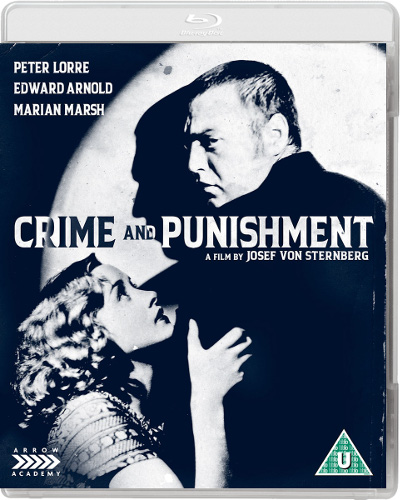
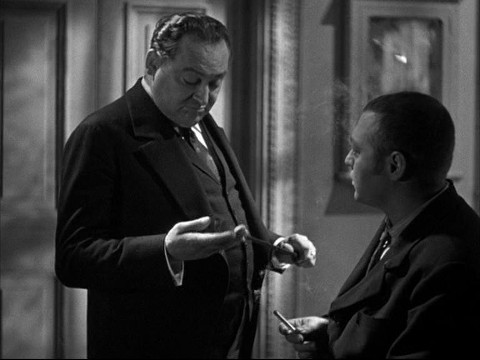
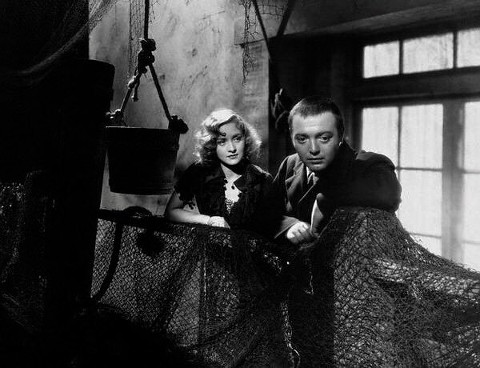

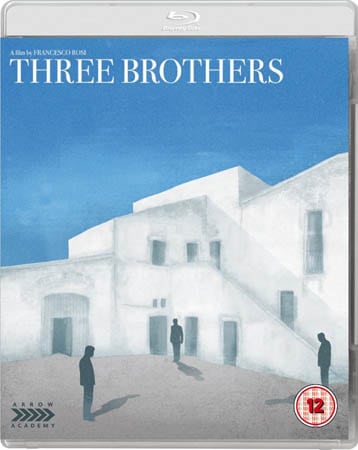
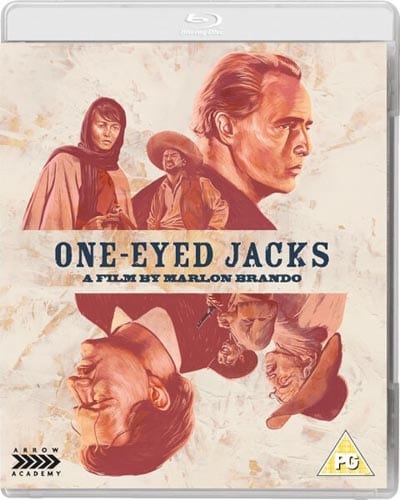
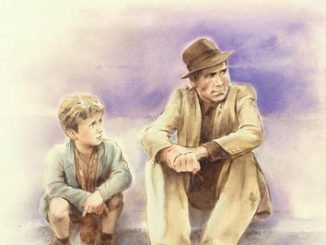
Be the first to comment